Introduction: A Floral Specialist in the Spanish Golden Age
Juan de Arellano stands as a prominent figure in the history of Spanish art, celebrated primarily for his exquisite flower paintings. Born in Santorcaz, near Madrid, in 1614, and passing away in Madrid in 1676, his life and career unfolded during the vibrant Spanish Golden Age, a period synonymous with the flourishing of Baroque art. Arellano carved a distinct niche for himself, becoming arguably the most important Spanish painter dedicated to the genre of floral still life in the 17th century. His work not only captured the ephemeral beauty of flowers but also reflected the artistic tastes and influences of his time.
While initially exploring other subjects, Arellano's eventual specialization in flower painting brought him considerable fame and success. His canvases are characterized by their dynamic compositions, rich coloration, and meticulous detail, securing his place in major collections and the annals of art history. Understanding Arellano requires exploring his artistic formation, the influences that shaped his style, his key works, his professional practices, and the ongoing scholarly discussion surrounding his legacy.
Early Life and Artistic Formation
Juan de Arellano's artistic journey began under the tutelage of Juan de Solis, a lesser-known painter of the era. This initial training likely exposed Arellano to the prevailing artistic trends in Madrid. During his early career, Arellano did not immediately focus on the still life genre that would later define his reputation. Instead, his initial output included works with religious and secular themes, aligning with the broader demands placed on artists during that period.
However, these early endeavors did not bring him significant recognition or financial stability. Sources suggest that his work in figure painting was perhaps not as distinguished or profitable as he might have hoped. This period of exploration laid the groundwork for his later specialization, providing him with foundational skills in composition and technique, even if his true calling lay elsewhere. The precise nature and extent of his early non-still life work remain less documented compared to his celebrated floral pieces.
The Strategic Shift to Floral Still Life
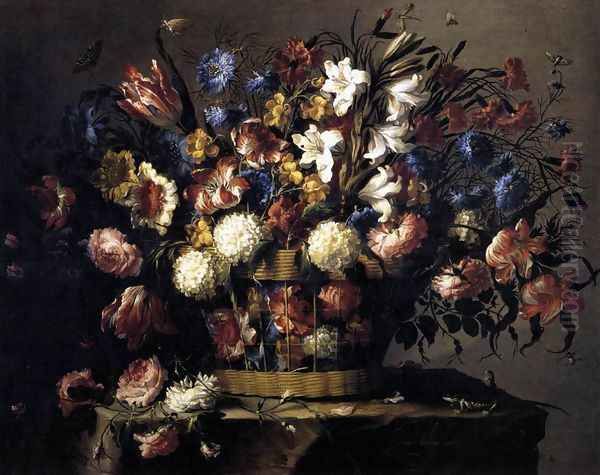
A significant turning point in Juan de Arellano's career occurred around the age of thirty. At this stage, he made a conscious decision to abandon figure painting and dedicate himself almost exclusively to the genre of flower painting. Contemporary accounts, including those by the artist and biographer Antonio Palomino, suggest this was a pragmatic choice as much as an artistic one. Flower painting reportedly offered higher financial rewards and involved comparatively less labor than complex figurative compositions.
This strategic shift proved highly successful. By focusing his talents on depicting intricate bouquets and garlands, Arellano tapped into a growing market for decorative still lifes among the Spanish aristocracy and bourgeoisie. His specialization allowed him to hone his skills in this demanding genre, rapidly gaining renown for his ability to render flowers with lifelike vibrancy and decorative flair. This decision shaped the remainder of his prolific career and cemented his historical importance.
Influences Shaping Arellano's Style
Juan de Arellano's distinctive style was not developed in isolation. His work clearly shows the impact of prominent European still life traditions, particularly from Flanders and Italy. Early in his career, influences from Flemish painters, such as the Jesuit artist Daniel Seghers, known for his elaborate flower garlands often surrounding religious scenes, are discernible. Seghers' precision and decorative arrangements likely provided an initial model for Arellano.
However, as his style matured, Arellano increasingly looked towards Italian masters. Painters like Mario Nuzzi, often called 'Mario de' Fiori' (Mario of the Flowers), became significant sources of inspiration. The Italian approach, often characterized by looser brushwork and more dramatic compositions compared to the meticulous detail of the Flemish, resonated with Arellano. He also absorbed influences from other Italian specialists like Margarita Caffi, adapting elements of their style into his own unique artistic language. This synthesis of Northern European precision and Italianate dynamism became a hallmark of his work.
Artistic Style and Signature Techniques
Juan de Arellano developed a highly recognizable artistic style characterized by several key features. His compositions are often dynamic and theatrical, typical of the Baroque era. He frequently arranged flowers in elaborate bouquets spilling out of baskets or vases, or woven into decorative garlands. While sometimes employing symmetry, his arrangements often possess a sense of movement and abundance, capturing the untamed beauty of nature within a structured format.
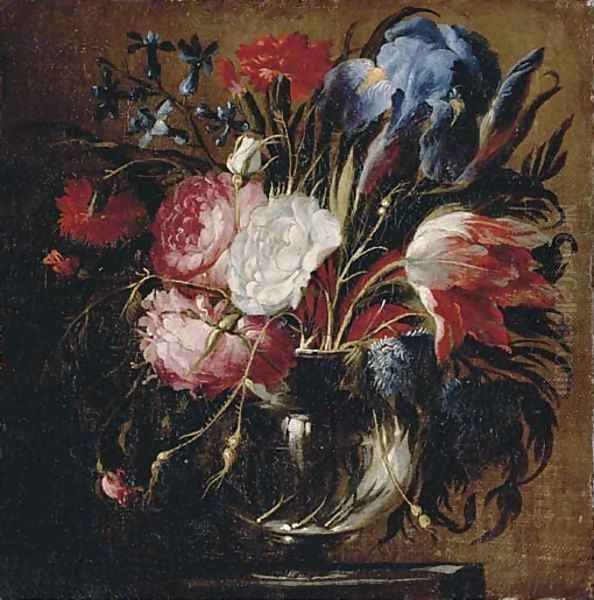
Color is central to the appeal of Arellano's paintings. He favored a vibrant palette, often dominated by the primary colors: rich reds, luminous yellows, and deep blues. His application of paint involved fine blending and subtle gradations (sfumato), allowing him to depict the delicate textures of petals and leaves with remarkable sensitivity. This technique imbued his flowers with a sense of vitality and captured the transient effects of light playing across their surfaces.
Beyond mere decoration, Arellano sought to convey the essence and even the emotional resonance of the flowers he painted. His meticulous observation allowed him to render specific species accurately, yet his arrangements often transcend simple botanical illustration. He masterfully manipulated light and shadow (chiaroscuro) to create a sense of depth and volume, making the bouquets appear almost tangible. This pursuit of capturing light, space, and the inherent life force of the flowers reflects the broader aesthetic goals of Baroque art and appealed greatly to the sophisticated tastes of his patrons. Works like his Glass Vase paintings exemplify his skill in balancing compositional order with naturalistic detail.
The Workshop and Commercial Success
Juan de Arellano was not only a talented artist but also an astute businessman. He established and ran a highly productive workshop in Madrid, which operated for several decades. This studio practice was crucial to his commercial success and prolific output. Within the workshop, Arellano employed other artists and assistants who worked under his direction, helping to produce the numerous flower paintings demanded by his clientele.
These workshop productions were typically sold under Juan de Arellano's name, benefiting from his established reputation. While Arellano himself would likely have overseen the quality and perhaps painted key passages, the assistance of other hands allowed him to meet market demand effectively. This model, common among successful artists of the period, enabled Arellano to become one of the most financially successful still life painters of his time in Spain. His focus on a popular and lucrative genre, combined with an efficient workshop system, secured his prosperity.
Major Works and Notable Collections
Juan de Arellano's legacy is preserved through numerous paintings held in prestigious museums and private collections worldwide. Several key works exemplify his mastery of the floral still life genre.
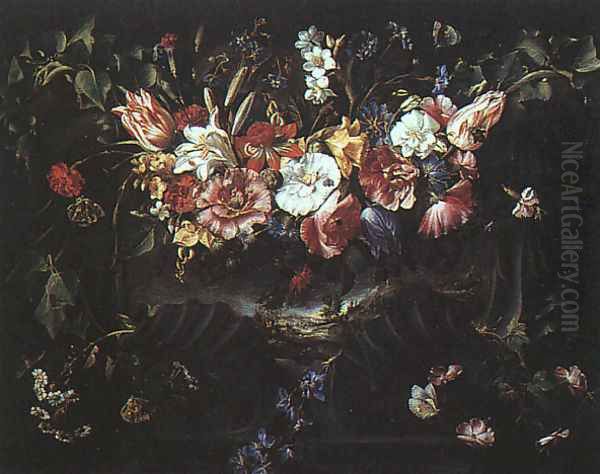
The Prado Museum in Madrid holds a significant collection of his works. Among these are Basket of Flowers (dated variously in sources, possibly c. 1652 or c. 1664) and Glass Vase (c. 1668). Another notable piece often cited is Garland with Landscape (c. 1652), showcasing his ability to combine floral elements with other genres, likely influenced by Flemish models like those of Daniel Seghers. These Prado paintings demonstrate his characteristic vibrant colors and detailed execution.
The Louvre Museum in Paris also houses important examples of his art. Bouquet of Flowers (c. 1660) is a celebrated work displaying his mature style. Another piece in the Louvre, Garland of Flowers, Birds and Butterfly, further illustrates his skill in creating complex, decorative compositions that often included elements beyond just flowers, adding to their visual richness and symbolic potential.
Other significant works include Tulips, Roses, Carnations and other flowers in a glass vase (1674), noted as being in a private collection in Stuttgart. This later work shows his continued dedication to the theme until the end of his life. Arellano also undertook commissions for decorative schemes, such as paintings for the sacristy of the church of San Jerónimo el Real in Madrid, demonstrating the application of his skills beyond easel painting. His works can also be found in other institutions, including the Guggenheim Museum Bilbao, attesting to his enduring appeal.
Artistic Circle: Teachers, Influences, and Followers
Juan de Arellano operated within a network of artistic relationships that included his teacher, the artists who influenced him, and those he influenced in turn. His primary teacher was Juan de Solis, who provided his initial training in Madrid. While Solis himself is not a major figure, this connection places Arellano within the broader context of Madrid's artistic milieu.
The most significant influences on his specialized work came from abroad. The Flemish painter Daniel Seghers and the Italian painters Mario Nuzzi ('Mario de' Fiori') and Margarita Caffi were crucial stylistic touchstones. Arellano skillfully adapted their approaches to floral depiction, creating a style that was both indebted to these European trends and distinctly Spanish in its sensibility.
Arellano's influence extended to his own family and workshop. His son, José de Arellano (documented as active between 1670 and 1705), followed in his father's footsteps, continuing the tradition of flower painting. His son-in-law, Bartolomé Pérez (whose active dates are sometimes cited, perhaps problematically, as early as 1616-1650, though his connection as son-in-law implies activity closer to Arellano's later career), was also a painter influenced by Arellano's style, specializing in floral themes and theatrical set design.
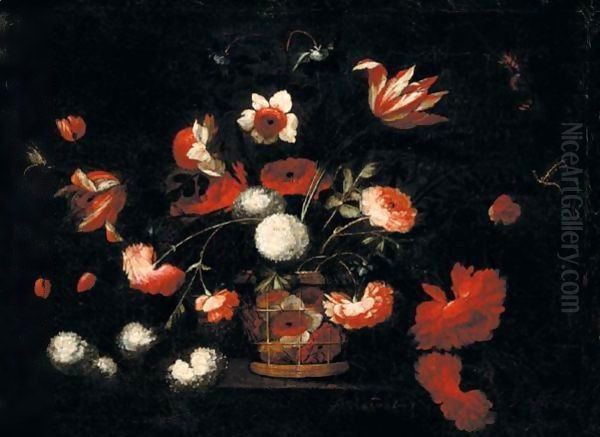
Beyond his immediate family, the numerous unnamed artists employed in his workshop over some forty years also worked within his established style. Furthermore, the art historian Antonio Palomino noted that Arellano associated with many painters in his later years, suggesting a broader circle of unnamed contemporaries, though specific details of collaborations or rivalries are scarce in the provided sources.
Academic Reception and Historical Legacy
Juan de Arellano is widely recognized by art historians as a leading figure, if not the foremost specialist, in Spanish Baroque flower painting. His technical skill, particularly in rendering textures and colors, is consistently praised. Works like Glass Vase are often highlighted for their sophisticated composition, balancing symmetry and naturalistic detail, and are seen as key contributions to the development of the still life genre in Spain. His ability to synthesize Flemish and Italian influences into a personal style is also noted as a significant achievement.
However, his historical status and artistic motivations have been subject to some debate. The fact that he turned to flower painting primarily for financial reasons has led some scholars to question the depth of his artistic commitment compared to contemporaries focused on more prestigious genres like history painting or portraiture. While undeniably successful and skilled within his chosen field, discussion persists regarding whether his overall artistic rank matches that of court painters like Velázquez or Carreño de Miranda.
Controversies or questions have also arisen concerning his social background and family origins, which can sometimes subtly influence historical evaluations. Some assessments might implicitly weigh his specialization in a 'minor' genre like still life against the grander ambitions of other Golden Age masters.
Despite these nuances, recent scholarship continues to affirm Arellano's importance. Re-evaluations emphasize his innovation within the still life genre and his significant impact on subsequent Spanish painters. His works remain highly esteemed in museum collections, admired for their beauty and technical brilliance. While debates about his precise rank within the pantheon of Spanish Golden Age artists may continue, his mastery of floral painting and his role in popularizing the genre are undisputed. His legacy is complex but secure as a defining painter of Baroque still life.
Conclusion: An Enduring Floral Master
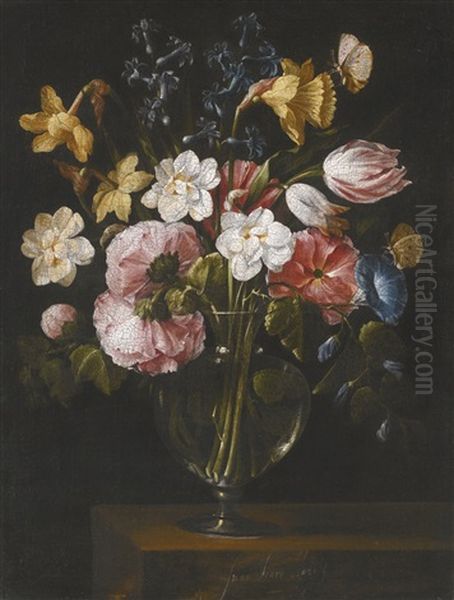
Juan de Arellano occupies a significant and specialized place within the rich tapestry of Spanish Baroque art. His decision to dedicate his career primarily to flower painting, driven by both artistic inclination and economic pragmatism, resulted in a body of work celebrated for its vibrancy, technical finesse, and decorative appeal. Drawing inspiration from Flemish and Italian masters like Daniel Seghers, Mario Nuzzi, and Margarita Caffi, he forged a unique and influential style.
Through his prolific output, facilitated by a successful workshop that included his son José de Arellano and son-in-law Bartolomé Pérez, he dominated the genre in 17th-century Spain. His paintings, found today in major institutions like the Prado and the Louvre, continue to captivate viewers with their intricate detail and lively compositions. While scholarly debate may touch upon his motivations and comparative rank, Juan de Arellano's enduring legacy as the preeminent Spanish master of Baroque flower painting remains firmly established. His work stands as a testament to the beauty and artistic possibilities found within the focused study of nature.